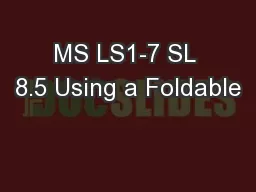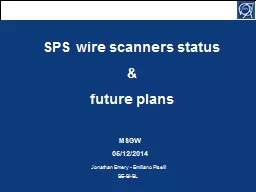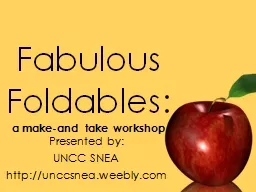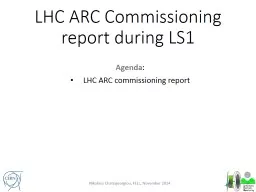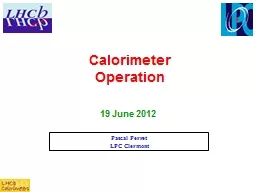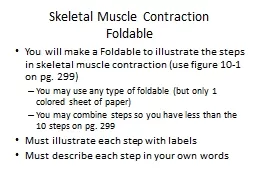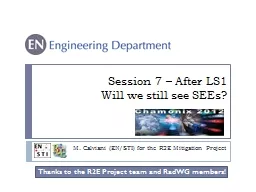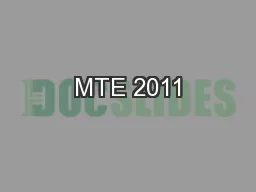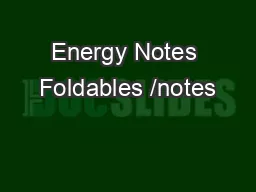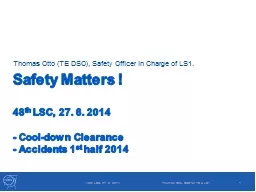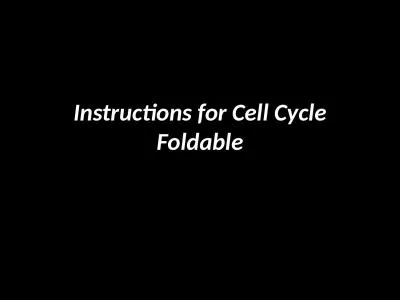PPT-MS LS1-7 SL 8.5 Using a Foldable
Author : karlyn-bohler | Published Date : 2018-02-22
to Describe Cycle of Matter and Energy in Organism and Ecosystems Created by D Peters MS LS17 Develop a model to describe how food is rearranged through chemical
Presentation Embed Code
Download Presentation
Download Presentation The PPT/PDF document "MS LS1-7 SL 8.5 Using a Foldable" is the property of its rightful owner. Permission is granted to download and print the materials on this website for personal, non-commercial use only, and to display it on your personal computer provided you do not modify the materials and that you retain all copyright notices contained in the materials. By downloading content from our website, you accept the terms of this agreement.
MS LS1-7 SL 8.5 Using a Foldable: Transcript
to Describe Cycle of Matter and Energy in Organism and Ecosystems Created by D Peters MS LS17 Develop a model to describe how food is rearranged through chemical reactions forming new molecules that support growth andor release energy as this matter moves through an organism Clarification Statement Emphasis is on describing that molecules are broken apart and put back together and that in this process energy is released Assessment Boundary Assessment does not include details of the chemical reactions for photosynthesis or respiration. W.Baldini. , N. . Bondar. , . . O.Maev,B. . Schmidt . LS1 . Muon. Meeting June-12th 2014 . Ongoing Activities . Grounding Improvement: . DONE. . Fixing problematic chambers in M2-5 (broken and noisy FEBs): . &. f. uture plans. MSGW. 05/12/2014. Jonathan Emery - Emiliano . Piselli. BE-BI-BL. 2. Outline. LS1. Prototype new wire scanner. Wire heating studies. Wire breakage mitigation solution implemented. Notebooks. Sally Creel . – . Sally.creel@cobbk12.org. . Your Guide to using . Interactive Notebooks. Essential Question: . EQ: . H. ow. do I use interactive notebooks to engage students and maximize learning in my classroom?. Foldables. :. a make-and take workshop. Presented by: . UNCC SNEA . http://unccsnea.weebly.com. What are . Foldables. ?. Foldables. are 3 dimensional interactive graphic organizers that students create with paper.. Agenda. :. VRGPE documentation (former VRJGE). Active Penning modification. By-Pass Valves modification. LHC ARC commissioning report. Nikolaos Chatzigeorgiou, FELL, November 2014 . VRJGE documentation. . Operation. Pascal Perret . LPC Clermont. 19 June 2012. Power . supply. Power glitches. Could be painful to recover …. In this case not only CALO is affected!. Could have an impact on L0 (timing!). Foldable. You will make a Foldable to illustrate the steps in skeletal muscle contraction (use figure 10-1 on pg. 299). You may use any type of foldable (but only 1 colored sheet of paper). You may combine steps so you have less than the 10 steps on pg. 299. 26.4.2013. 25/4/13 ALICE TB. Status of LS1 activities - A.Tauro. 2. LS1 plan. 2013. Weeks. Remove plug, mobile shielding, open doors. 8-9. Prepare for PHOS extraction, remove RB24 beampipe and PMD. 10. Will we still see SEEs?. M. Calviani (EN/STI) for the R2E Mitigation Project. Thanks to the R2E Project team and RadWG members!. Introduction. 2. R2E Project mandate:. SEEs should allow LHC operation with . workshop. PS BI Instrumentation Status. Stephane Bart Pedersen. BE-BI 2011. Core Beam Instrumentation for MTE. . PS Ring:. Orbit system . Wire-scanners. BLMs. DC BCT. TT2:. BPM (trajectory). . Intolerable Acts Opening. Intolerable. – Impossible to endure; unbearable.. Coercive. – to act by force; strong-arm. After the Boston Tea Party, England passed a series of strict new laws to punish the colonists. In England, they referred to the 4 new laws as . Major Sources of Energy (triangle foldable. ). *Sun: . MAJOR. source of energy for life on EARTH. Light and heat energy. Warms earth. *Geothermal:. Energy within Earth. Produces heat. Can be used for human energy needs. LSC, . 27. 6. . 2014. - Cool-down Clearance. - Accidents 1. st. half 2014. Thomas Otto (TE DSO), Safety Officer in Charge of LS1.. 48th LSC, 27. 6. 2014. Thomas Otto, DSO for TE & LS1. 1. Cool-down clearance. IMPORTANT!!!. Use your Cell Cycle Notes from . Monday . to help you!!!. Folding and Cutting. Fold your paper in a tri-fold. . Landscape orientation and fold sides to center line.. Measure paper and cut the fold so that there are 4 flaps on each side..
Download Document
Here is the link to download the presentation.
"MS LS1-7 SL 8.5 Using a Foldable"The content belongs to its owner. You may download and print it for personal use, without modification, and keep all copyright notices. By downloading, you agree to these terms.
Related Documents

